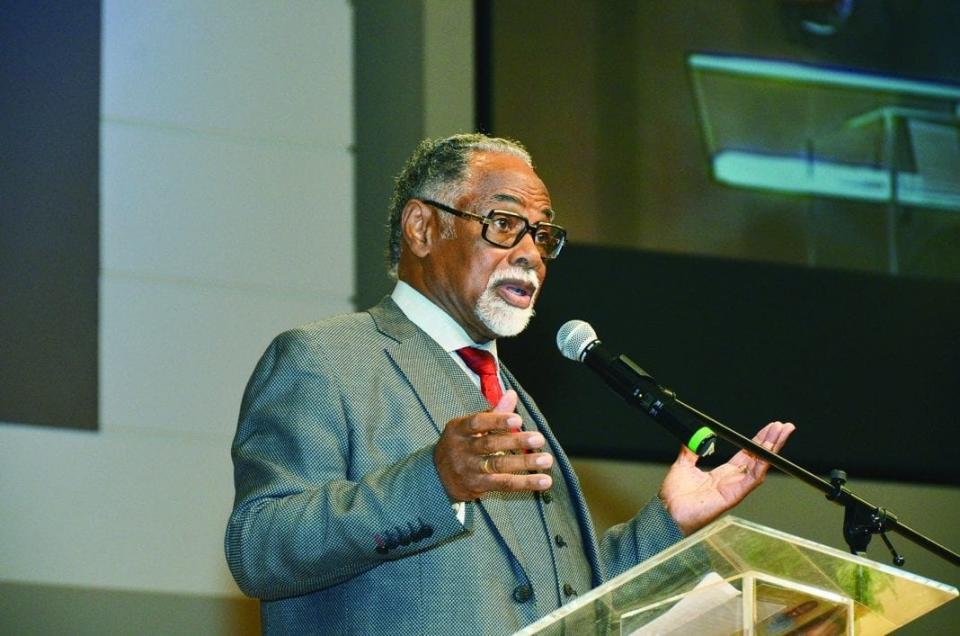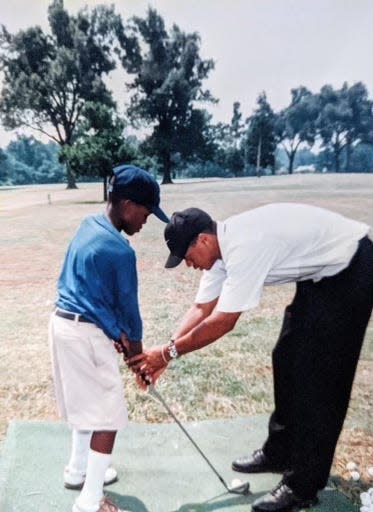Out of Bounds: The history of African Americans and golf in Memphis explained
Editor's note: This is an excerpt from "Out of Bounds: A History of African Americans and Golf in Memphis, Tennessee," reprinted with permission from the author, the Rev. L. LaSimba M. Gray Jr., who seeks to document the rich history of African Americans in golf in Memphis. The book was released on Juneteenth, June 19, 2024.

When the announcement was made in 2021 of the massive renovations of the Pine Hills Golf Course, the thought occurred to me: What will happen to all of that history?
The history of African Americans in golf, which began at Lincoln Park Golf Course (1935), Douglass Golf Course (1951), and the iconic T.O. Fuller Golf Course (1956), had not been told.

I made a phone call to Bobby Hall, a retired sportswriter for The Commercial Appeal. My opening question was, “Is there a recorded history of the desegregation of golf in Memphis?" Bobby replied that he was not aware of any such documentation, made a couple of referrals, and wished me well.
The next morning, Bobby called me, exclaiming, “Your question about the desegregation of golf in Memphis is one of the most intriguing I've heard since my retirement." I knew then I had a mission: to document this rich history of African Americans and golf in Memphis, Tennessee. When I returned to Memphis in 1973, most African Americans who played golf gathered at T. O. Fuller Golf Course. It was the first 18-hole course built for African Americans during segregation. When T. O. Fuller Golf Course closed in 1987, the venue of choice became Pine Hill. Centrallylocated and easily accessible, Pine Hill was the first municipal golf course in Memphis that allowed African Americans to play. The management there helped build an atmosphere of fraternal relationships.
Lerone Bennett, the celebrated historian, said, “If African-American youth are to make history, they must know their history.” The history of African Americans in golf has not been told. As the author of this work, I fear that if it's not documented in 2022, this rich history will be lost to Alzheimer’s, amnesia, and the passage of time. What a tragedy it would be if golfers were denied the contributions made by African Americans in Memphis, Tennessee.
From the building of golf courses to the manufacturing of golf clubs, African Americans have been there. We cooked in the country clubs, maintained the courses, carried the bags, cleaned the shoes, found the balls, and read the breaks on the greens. We didn’t fight for credit and coverage. We were often told, “Show up, keep up, and shut up.”
I am well beyond adhering to those rules and must now tell the story.
From 1896 to 1962, African Americans could not benefit from the Park System and outdoor recreational opportunities provided by taxpayers in Memphis. Golf was first introduced to Memphis via private country clubs in 1896, and the general public was introduced to it via public courses in the early 1900s.
The exclusion from public parks and golf courses was so severe politically that Robert R. Church Sr. built the first park for African Americans on Beale Street with his own money in 1899. Church Park was said to be the only facility of its kind for African Americans in the country, yet it did not include golf.
If the original premise for creating parks and outdoor recreation was for a “healthier Memphis,” then the exclusion of African Americans meant their physical and mental health did not matter in Memphis, Tennessee.
For about 66 years, African-American golfers were considered “out-of-bounds” in public and private golf clubs in Memphis. The debate continues: “How can the path to the PGA be made smoother? And can we make up for lost time due to racism and blatant discrimination?" The answers may lie in the newly formed LIV (Golf League), which provides new options for African-American golfers. It began with no exclusion of golfers by race and large financial backing. LIV and PGA remain competitive, although in 2023 the two leagues entered a framework agreement to work together.
Golf comes to America
On the wings of immigration in the 18th Century, golf made the Transatlantic trip from Europe to America. Scottish immigrants brought the passion for golf and the skills to make needed equipment. Historians suggest that the origins of golf lie in the boredom of shepherds watching sheep and goats.
While waiting and watching, these shepherds began to hit rocks with sticks. This pastime soon turned competitive, and the competition spread to various villages in Scotland. It was during these street competitions that the popularity of the game began to grow.
Scotland was an ideal setting for this embryonic stage of golf. The landscape, punctuated with open spaces used for pastures, lacked trees, and the grazing sheep and goats kept the grass trimmed low. This shift from the streets to the pasturelands marked a significant development in the game.
While immigration is recognized for facilitating the transport of golf to America, the role of the cotton trade cannot be overlooked. Merchants, eager to supply the mills of Europe with raw material for fabric, found new supply lines in America, especially in the South. This economic activity inadvertently supported the introduction and growth of golf in the region.
Reportedly, the first golf course outside the United Kingdom was the South Carolina Golf Club in Charleston, South Carolina. From Edinburgh, Scotland, to Charleston, South Carolina, golf found a new home in America, setting the stage for its expansion and evolution.
Golf comes to Memphis
Mr. J. P. Edrington is credited with bringing the game of golf to Memphis. On December 10, 1896, a select group of Memphians, eager to play golf, organized the Memphis Golf Club, which later became the Memphis Country Club. J. P. Edrington was elected president and soon dominated the club championships, often being compared to golfing legend Bobby Jones.
The first course was laid out at the head of Peabody Avenue (see diagram). Conveniently, J. P. Edrington lived on Peabody, adjacent to the course. W. V. Hoare was elected as the first professional. The original nine holes, located just north of Vance Avenue near East Street, averaged approximately 300 yards in length, and tomato cans served as holes. Golf clubs were scarce, prompting J. P. Edrington to allow members to use his. By the fall of 1897, the interest in golf had grown significantly in Memphis. Many members purchased their own clubs, cementing golf's place in the city.
The acceptance and growth of golf in Memphis were also influenced by the impact of cotton on the local economy. The surrounding land, once used for cotton cultivation, played a key role. Notably, the Pine Hills Golf Course, now public property, was originally part of a 2000-acre plantation owned by Colonel William Person. Similarly, the Cherokee Country Club originated on farmland near Caperville, east of Memphis; Colonial Country Club was established near Cordova, and Windyke Country Club in the Germantown/Collierville area.
Golf's introduction to America during the post-Reconstruction era of the 19th century coincided with an America deeply entrenched in segregation. The withdrawal of federal troops from the South and the failure of the Freedmen’s Bureau to transform Southern society left the region ripe for the resurgence of old social orders.
Historians cite three main reasons for the failure of Reconstruction: convict leasing, sharecropping, and the unchecked terrorism of the Ku Klux Klan. Add to this the segregation in schools, housing, and jobs, along with lynchings, and one finds America struggling to truly free its former slaves.
More: As Confederate statues fall and protests arise, civil rights museums are key to explaining why
From 1863 to 1963, freedom for African Americans vacillated between dreams and nightmares. Dreams kept hope alive amidst the harsh reality of second and third-class citizenship. The nightmare manifested daily in employment inequities, lynchings, limited access to capital, and unequal public accommodations.
In Memphis, golf quickly became a segregated haven of Anglo-Saxon society. The golf country clubs emerged as citadels of white supremacy, defining specific roles for African Americans as caddies, cooks, janitors, groundskeepers, and greenkeepers.
More: The Commercial Appeal makes donation to Ida B. Wells statue effort in Memphis
In 1900, Memphis began constructing public parks for outdoor recreation. Overton Park allowed non-country club members exposure to golf, yet African Americans were excluded. Riverside was built on the southwest side of Memphis for the growing population, which had reached 102,320 by this time.
In 1899, after numerous failed appeals to city leaders for recreational outlets for African Americans, Robert R. Church Sr. built Church Park on Beale Street. This historic park, built entirely with private funds, did not include a golf course.
Douglas Park, established in 1913 in Northeast Memphis on 53 acres, added a nine-hole golf course in 1951. Lincoln Park, built in 1935 in the Bunkerhills area, originally had a seven-hole course, which was later closed following the construction of the course in Douglas Park.
You can find the book in Memphis at the following locations: New Sardis Baptist Chruch, 7739 E. Holmes Rd.; Tennessee Regular Bookstore, 1055 Bellevue Rd.; Miles CME Bookstore, 4237 Elvis Presley.
The Rev. L. LaSimba M. Gray Jr. is a historian, civil rights leader and pastor emeritus of New Sardis Baptist Church on Holmes Rd. in Memphis.
This article originally appeared on Memphis Commercial Appeal: Black golf history in Memphis explained

